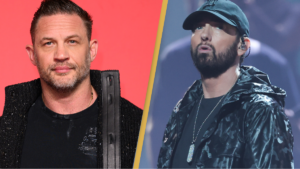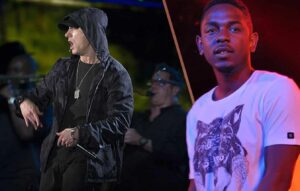Eminem, often hailed as one of the greatest rappers of all time, has faced his fair share of criticism and praise throughout his career. Recently, American rapper and DJ Lord Jamar made waves with a bold statement about Eminem, claiming he is “overrated” and that his music lacks meaningful content. Jamar’s comments sparked heated debates among hip-hop fans and music enthusiasts alike. But is there any truth to his allegations? Let’s dive into this critique and break down the points raised.
The Criticism: Is Eminem Just “Screaming” on the Mic? 🎤

Lord Jamar’s main critique of Eminem revolves around his delivery. According to Jamar, Eminem’s approach to rapping is characterized by excessive screaming and a lack of substance in his lyrics. The argument here is that while Eminem is undeniably skilled at putting words together, the content of his music often falls short. Jamar’s point seems to suggest that rapping isn’t just about stringing together rhyming words, but rather about conveying something meaningful.
Eminem’s style, which includes a fast-paced delivery and dramatic tone shifts, has often been a polarizing aspect of his music. Some fans argue that this intensity is what makes his music stand out, while others, like Jamar, view it as excessive. The question then arises: Does the screaming detract from the message, or does it serve to enhance the raw emotion and energy in his music?
The Content Debate: Can Eminem’s Lyrics Be Taken Seriously? 🤔
One of Jamar’s most scathing critiques is that Eminem’s lyrics often lack substance. He points to the rapper’s well-known tracks about personal conflicts, such as his troubled relationship with his mother, and dismisses them as meaningless. Jamar’s viewpoint reflects a larger debate within hip-hop about the balance between lyrical depth and entertainment value.
Eminem’s fans often point to the emotional weight behind his songs, particularly his willingness to confront his demons in his lyrics. Songs like “Cleanin’ Out My Closet” and “Mockingbird” are raw and vulnerable, providing a glimpse into the rapper’s life struggles. However, Jamar suggests that just because Eminem touches on personal topics doesn’t mean the content is necessarily profound. From Jamar’s perspective, simply airing grievances through music doesn’t automatically make it high art.
The “Rhyming for the Sake of Rhyming” Argument 🧐

Lord Jamar also criticizes Eminem for using unconventional and often nonsensical rhyme schemes, including word pairings like “cat, rat, bat, hat.” He argues that if rhyming was all it took to be a great rapper, then anyone could do it. This statement brings attention to a key element of hip-hop: the art of lyricism. Eminem’s ability to rhyme complex words and create intricate flows is undeniably impressive, but does it overshadow the importance of lyrical depth and coherence?
Many rappers, including Tupac, Biggie, Jay-Z, and Nas—whom Jamar praises—are known for their ability to combine skillful rhyme with deep, thoughtful content. These artists often address societal issues, personal struggles, and thought-provoking themes in their music. In contrast, Eminem’s approach can sometimes lean more toward shock value and wordplay over deeper messages. While this might resonate with some fans, others, like Jamar, argue that this approach fails to elevate the genre.
Eminem’s Controversial Themes: The “Dre’s Daughter” and G@y References 🌈
One of the more controversial statements Jamar makes is regarding Eminem’s use of provocative themes, such as his famous line about offering his daughter to Dr. Dre in “Forgot About Dre.” This, along with various references to sexuality and profanity in his songs, has often drawn criticism for being overly crude or shock-driven. Jamar seems to suggest that Eminem’s willingness to say anything, regardless of the consequences, reflects a lack of substance.
Eminem has never shied away from controversy, often using his lyrics to address sensitive or taboo subjects. Some see this as a form of artistic expression, while others view it as an attempt to garner attention rather than create meaningful art. Eminem’s exploration of uncomfortable themes—like his strained relationship with his mother or his alter ego, Slim Shady—has been both celebrated and condemned. Does this rawness make his music more authentic, or does it detract from the message he’s trying to convey?
The Legacy Debate: Eminem vs. The “Real GOATS” 🏆
Perhaps the most interesting part of Jamar’s critique is his comparison of Eminem to other rap legends, including Tupac, Biggie, Jay-Z, and Nas. These artists are often regarded as the pillars of hip-hop, known for their lyrical prowess, storytelling ability, and cultural influence. Jamar suggests that these “real GOATS” never resorted to gimmicks or meaningless wordplay, which he claims sets them apart from Eminem.
This raises an important question: What makes a rapper great? Is it their ability to tell a powerful story, create social change, and convey deep emotions through their lyrics? Or is it their technical skill in rhyming, flow, and delivery? In many ways, the debate between Eminem and these other rap legends comes down to personal preference. Some fans view Eminem as a true innovator, while others—like Jamar—prefer the more grounded, socially conscious approach of Tupac, Biggie, Jay-Z, and Nas.
Conclusion: Is Eminem Overrated? 🔥

Lord Jamar’s harsh critique of Eminem raises valid points about the balance between style and substance in rap music. While Eminem’s technical skill is undeniable, his critics argue that his reliance on shock value, controversy, and rapid-fire rhyme schemes can overshadow the depth and meaning that hip-hop has traditionally been known for.
At the same time, Eminem’s fans would argue that his emotional intensity, honesty, and impact on the rap game make him a true legend. Whether you view him as overrated or not likely depends on what you value most in a rapper: the technical skill or the deeper messages within the music.
In the end, the debate between Eminem and his critics is far from settled, but it’s a testament to the power of hip-hop to spark passionate discussions and challenge artistic boundaries. 🙌



